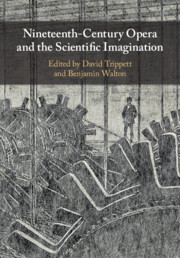Book contents
- Nineteenth-Century Opera and the Scientific Imagination
- Nineteenth-Century Opera and the Scientific Imagination
- Copyright page
- Contents
- Figures
- Tables
- Music Examples
- Contributors
- Acknowledgements
- Introduction
- Part I Voices
- Part II Ears
- Part III Technologies
- Part IV Bodies
- 11 Excelsior as Mass Ornament
- 12 Automata, Physiology and Opera in the Nineteenth Century
- 13 Wagnerian Manipulation
- 14 Unsound Seeds
- Bibliography
- Index
11 - Excelsior as Mass Ornament
The Reproduction of Gesture
from Part IV - Bodies
Published online by Cambridge University Press: 07 August 2019
- Nineteenth-Century Opera and the Scientific Imagination
- Nineteenth-Century Opera and the Scientific Imagination
- Copyright page
- Contents
- Figures
- Tables
- Music Examples
- Contributors
- Acknowledgements
- Introduction
- Part I Voices
- Part II Ears
- Part III Technologies
- Part IV Bodies
- 11 Excelsior as Mass Ornament
- 12 Automata, Physiology and Opera in the Nineteenth Century
- 13 Wagnerian Manipulation
- 14 Unsound Seeds
- Bibliography
- Index
Summary
In her 1984 ‘Cyborg Manifesto’, Donna Haraway declared: ‘the relation between organism and machine has been a border war’ in Western science and politics – which for her primarily amounted to a racist, male-dominated capitalism, as embodied by the notion of technological progress. Her manifesto identified that ‘The stakes in the border war have been the territories of production, reproduction and imagination’, each of these zones representing its own contentious interface between organism and machine within American post-industrial society: the encroachment of robots in industrial production; the use of test tubes for reproducing the body; the ascendancy of sci-fi imagination in literature and film. And in each case the battles weren’t being won by humans. Haraway was instead confident of a machine victory, pushing her towards a notorious conclusion: we are cyborgs.
- Type
- Chapter
- Information
- Nineteenth-Century Opera and the Scientific Imagination , pp. 251 - 268Publisher: Cambridge University PressPrint publication year: 2019
- 1
- Cited by

